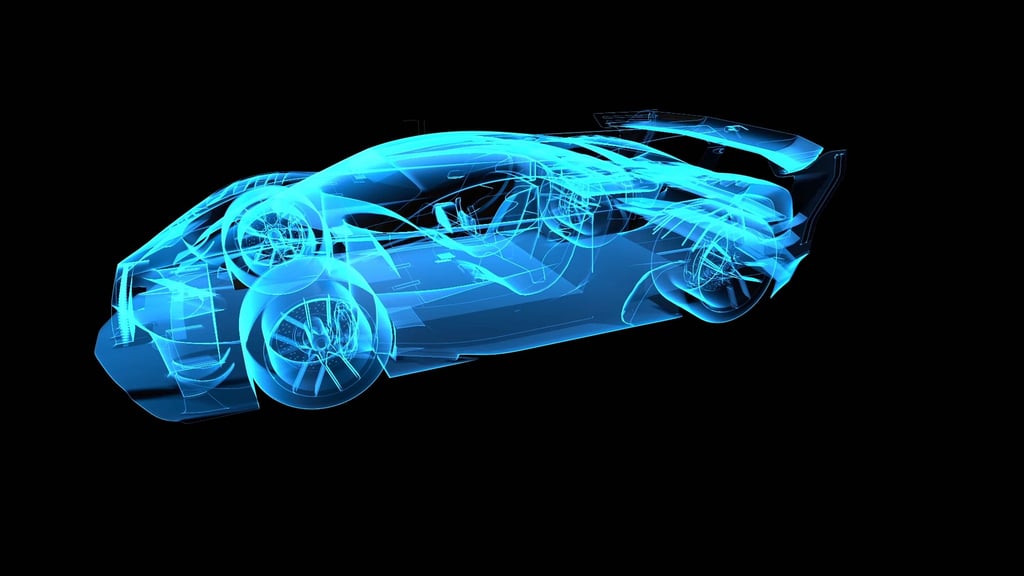

Detailed virtual model of a car acting as a digital twin for a physical car.
Enterprises that deliver top-tier products make quality testing and future planning a huge part of their production process. But what happens to the product or physical entity once it enters into the “real world”? How can enterprises be sure that the product lives up to the standards set before it? A digital twin can help, […]


Enterprises that deliver top-tier products make quality testing and future planning a huge part of their production process. But what happens to the product or physical entity once it enters into the “real world”? How can enterprises be sure that the product lives up to the standards set before it? A digital twin can help, acting as a virtual solution for tracking these products at every stage of their life.
Digital twins are best described as minutely detailed virtual models of real objects or processes that react to and change according to the same environmental factors and scenarios that affect the real physical entity. They are similar to simulations and other virtual models, but no other type of model provides the holistic detail and real-time updates that a digital twin can provide. Digital twins can represent anything from a car to a large factory setup to an airplane engine. Read on to learn more about how digital twins work and how they’re currently benefiting the enterprise world of visualization and analytics.
Read Next: The Growing Value of Enterprise Architects
Digital twins are automatically updated in real time based on what’s happening to the actual product or process in the real world. This real-time adjustment to the model is made possible through Internet of Things (IoT) sensors found on the physical product(s).
Several IoT sensors are placed on the original object, but primarily on areas of core functionality or sensitive areas that can easily be damaged or disrupted. These sensors track change over time and performance metrics on the physical item; then, that information is transmitted to processors that apply those changes and metrics to the digital twin so that it exactly matches the original object.
Engineers test their hypotheses, process guidelines, and product plans against incoming data from products in the field that are connected to digital twins. Digital twin models make it possible for your enterprise to collect real-time performance data, which enables you to make informed product updates, expand on popular features, recall or adjust poor functionalities, and know exactly what customers are experiencing when they speak to customer service.
Preparing Data for AI and Machine Learning: What is Data Annotation?
Digital twins can benefit enterprises in several strategic areas of efficiency and quality assurance. Some of the top benefits realized by enterprises that implement digital twin technology include the following:
Whether a product is in its earliest production phase or has been out on the market for several months or years, digital twins allow you to test several product features in real time. This real-time, ongoing tracking allows enterprises to test how they’re performing on the product promises they’ve made to consumers.
Digital twins often represent larger processes or collections of technology, such as those found in a factory assembly line. When IoT sensors deliver real-time data on all key areas of a factory’s manufacturing tools and procedural steps, your enterprise can easily discover what’s working, what’s broken, and if any inefficiencies or bugs need to be adjusted for optimal performance. No need for an engineer to step into the facility and assess each piece of equipment, because the data is at their fingertips with a digital twin.
The best predictive analytics pull performance data from several databases, but with a digital twin approach you can expand beyond that pool of data, with real-time data on all core features of the source object. Since a digital twin lets you know how the object is performing as it happens, you can make more accurate predictions about future needs. It’s also quite likely you did not plan for everything that could happen to the object, but a digital twin allows you to track those unexpected scenarios and add that data into future planning objectives.
Since digital twins make it possible for you to automatically track physical objects in the field, you can also track when they’re on the verge of breaking or needing an update. Catching these needs before the object breaks or progresses into bigger problems amounts to huge savings in maintenance costs.
Read Next: Top AIOps Companies in 2021
Enterprises are most directly impacted by digital twins in their network, but consumers often reap the benefits too:
Digital twins can be expensive to implement, and in many cases, they provide more advanced real-time analytics than an enterprise really needs. Most often, you’ll find digital twin technology in industries like hospital networks, construction and civil engineering, factory settings (especially automotive), and industries that manufacture large and highly technical equipment, such as wind turbines.
Despite their somewhat specialized use cases, the digital twin market has grown quickly and isn’t stopping. The market is poised for an impressive compound annual growth rate of 58%, growing from $3.1 billion in 2020 to a projected value of $48.2 billion by 2026, according to Markets and Markets Research. A lot of the most recent growth is attributed to the COVID-19 pandemic and the growing need in the healthcare and pharmaceutical sector to track pandemic data in real time.
To keep up with the quickly expanding digital twin market, the Digital Twin Consortium was founded by several top technology companies to instill best practices and innovation into digital twin development. With their focus on ethical development and engaging more companies in the space, the digital twin market growth trajectory looks steady and promising.
Read Next: What is an NFT?


Shelby Hiter is a writer with more than five years of experience in writing and editing, focusing on healthcare, technology, data, enterprise IT, and technology marketing. She currently writes for four different digital publications in the technology industry: Datamation, Enterprise Networking Planet, CIO Insight, and Webopedia. When she’s not writing, Shelby loves finding group trivia events with friends, cross stitching decorations for her home, reading too many novels, and turning her puppy into a social media influencer.

Enterprise Networking Planet aims to educate and assist IT administrators in building strong network infrastructures for their enterprise companies. Enterprise Networking Planet contributors write about relevant and useful topics on the cutting edge of enterprise networking based on years of personal experience in the field.
Property of TechnologyAdvice. © 2025 TechnologyAdvice. All Rights Reserved
Advertiser Disclosure: Some of the products that appear on this site are from companies from which TechnologyAdvice receives compensation. This compensation may impact how and where products appear on this site including, for example, the order in which they appear. TechnologyAdvice does not include all companies or all types of products available in the marketplace.